#spike spiegel sequences
Explore tagged Tumblr posts
Text
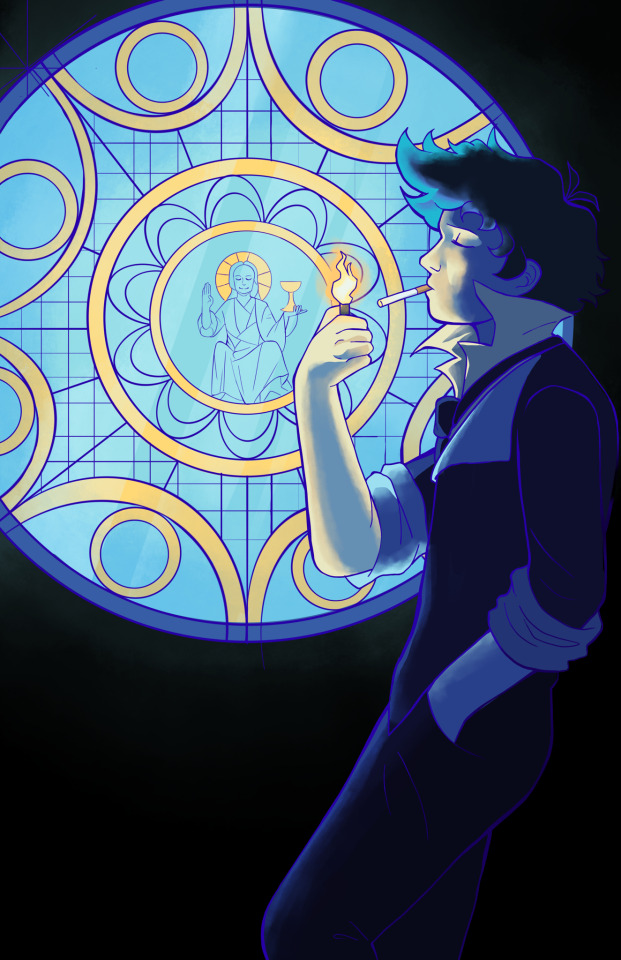
nice window you’ve got there. it’d be a shame if someone were to…. fall out of it
#cowboy bebop#spike spiegel#i told you guys i’ve been on a space dude kick recently#my art#this is my first animation (that isn’t just a blink) in a looooooong time lol#i didnt do it in an animation program i just exported a bunch of layer groups and hoped they made an ok sequence 😭#i’ve never rlly found an animation program i really loved so instead i’ve doomed myself to layer hell#feel free to make your phone background or something i think that’s what i’m gonna do :))
58 notes
·
View notes
Text
Te o Toriatte
I wrote a 10.000 word story titled "Te o Toriatte".
It's mainly a Spike Spiegel adventure, but it features the remainder of the Cowboy Bebop gang, along with some other misfits.
Here's the cover art, courtesy of @lonichedgehog.

And the synopsis:
A Christmas gift for Spike Spiegel triggers a sequence of events that leads the Bebop's crew to the dwarf moon of Io. For once they are sleuthing, not bounty hunting. Even though detective work isn't really their thing, they get lucky. And when Spike crosses paths with their opponent, he ends up beguiled. Will he be able to forget Julia?
Chapter 1 coming tomorrow!
#cowboy bebop#spike spiegel#anime art#japan#my writing#fanfic#cowboy bebop fanfiction#cowboy bebop fanart
13 notes
·
View notes
Text

I just finished binge-watching Cowboy Bebop: the live-action version and the original anime. I'm dipping my toes back into blogging to offer a little comparison and some thoughts on both.
I initially watched the anime in the early 2000s, when it first became available in the US in English. I was about 13. I remember having a strong attachment to the characters, especially Ed and Ein, generally liking the show, and loving the theme song. It was also, almost definitely, the first anime I'd ever seen, so the novelty of it might have been part of what had me enraptured.
The show hits very differently at 36 than it did at 13. It seems clear to me that Ed and Ein were added for comic relief, because the rest of the show is pretty damn dark. It's about a group of bounty hunters (basically freelance cops, not heroes) who are always broke, always hungry, and [spoiler alert] never seem to catch the "bad guys." They are also set up by the system to fail/never receive a major payout.
Apparently the live-action version has gotten a lot of bad press, so I'll start with what I liked about it.
The aesthetics are probably number one. If you have a weakness for antiquated technology like I do, you may get a kick out of seeing VHS tapes, flash drives, and old-ass computers in the "future."
I also thought the show did a great job with costumes, specifically matching them to the original anime. It's particularly striking with the characters of Katerina Solensan (ep. 1 of the live action) and Maria Murdock (ep. 4 of the live action). I appreciated the update to Faye Valentine's outfit: She still looked tough and sexy, but wasn't nearly as nude.
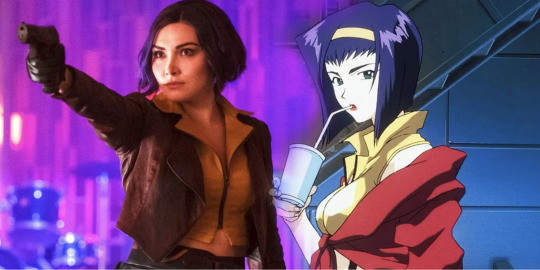
Speaking of updates, the live-action version is way less racist, sexist, and transphobic than the original. I remembered none of that from my initial viewing, but rewatching the original, it was pretty hard to ignore. I appreciate the creators of the live-action version for that.
The casting, another strength, probably helped. I think making Jet Black actually Black was a great choice. I wasn't initially sold on John Cho as Spike or Daniella Pineda as Faye, but they grew on me over the course of the show (especially when I learned that Pineda is Mexican, from Oakland, and went to the same college as I did).

Also, the live action version is way gayer (and kinkier) that the anime.
Now on to what I didn't love.
It seems hard to play a cartoon character. I thought all the main actors did a fine job, but so much of what made the anime characters lovable made the live-action characters unbearable. In the original, Jet has real strong grumpy dad vibes, Spike is the too-cool-for-school older brother, and Faye is the annoying kid sister. (None of them are blood-related.)
All of those traits were essentially retained, but while it's ok for a cartoon character to be flat, a live-action character has to be, well, three dimensional. For example, in the live action, Jet seems super one note, his one note is trying to be a good dad. The original Jet didn't have a kid, and I thought giving him one was an odd choice.
When I first watched the anime at 13, Spike Spiegel seemed *so cool.* Upon rewatching the cartoon, I realize what signified coolness then was his constant drinking/smoking, fearlessness, detached demeanor, and fighting abilities.
Rewatching it as an adult, his smoking and drinking seem like addictions, his fearlessness comes across as a death wish, and his detachedness comes across as insufferable arrogance and emotional repression.
It seems clears that Spike has PTSD, but refuses to talk about his feelings/memories/trauma with anyone, despite Jet offering the space to share several times (ep. 2). So much the show is about toxic masculinity, which I'll get into in a later post.
Spike's fighting skills are still pretty sick though. I thought the live-action fight sequences were well-choreographed and fun to watch. And of course, in both the anime and the live-action version, all fight scenes are set to incredible music. In both versions, the opening title sequence is a real highlight. And not just because the theme song rules... but it really does.
Part two, coming soon.
youtube
5 notes
·
View notes
Text
Blizzard teases Cowboy Bebop crossover for Overwatch 2

Season 9 of Overwatch 2 kicks off subsequent week, with some huge modifications to the sport’s aggressive mode, a brand new battle move, and a cosmic horror theme for hero skins. However Blizzard Leisure’s sneak peek at season 9, named Champions, additionally hints at one thing shocking: a crossover with beloved anime sequence Cowboy Bebop. A short teaser tucked on the ending of a trailer for Overwatch 2 season 9 incorporates a sight acquainted to longtime Overwatch gamers. A tumbleweed, signaling that Cassidy’s final is about to pop off, rolls via the abandoned streets of Route 66. Then there’s a minimize to the jukebox, which begins taking part in the Cowboy Bebop theme song, “Tank!” Blizzard hasn’t introduced an Overwatch 2/Cowboy Bebop crossover but, however that’s a crystal-clear trace. And there’s a precedent for anime crossovers: Virtually precisely one 12 months in the past, Blizzard teased the primary (non-Lego) IP collab for Overwatch, based mostly on One-Punch Man. That occasion added a wide range of themed skins and different cosmetics to the sport, within the type of Saitama Doomfist, Genos Genji, Horrible Twister Kiriko, and Mumen Rider Soldier: 76. A Cowboy Bebop crossover would nearly assuredly imply a Spike Spiegel pores and skin for the cowboy Cassidy, however may it additionally imply a Faye Valentine pores and skin for Tracer? A Vicious pores and skin for Genji? Edward and Ein skins for Ashe and Bob? OK, that final one could be a stretch, however we’re positive to search out out quickly. Overwatch 2 season 9 begins on Feb. 13. Any potential Cowboy Bebop crossover would probably arrive inside two months after that season’s launch, based mostly on previous season lengths. Source link Read the full article
1 note
·
View note
Text
If you ever have a free afternoon I highly recommend going through this article and taking your time with it.
1 note
·
View note
Video
youtube
The opening credits sequence for the live action Cowboy Bebop adaptation starring John Cho as Spike Spiegel, Daniella Pineda as Faye Valentine, and Mustafa Shakir as Jet Black.
Releasing on Netflix on November 19.
#*breathes in*#AHHHHHH#LOOK AT THAT NOSTALGIA BANKING#I LOVE IT#I WATCHED THE LIVESTREAM FOR TWO HOURS#WORTH IT#cowboy bebop#cowboy bebop netflix#faye valentine#spike spiegel#jet black#john cho#daniella pineda#mustafa shakir#how many more tags huh
7 notes
·
View notes
Text

groups these two together BUT YEAH EXACTLY god 'mellow kooky' like, she can be chill when she wants to, yeah, sure, not all excitable people are on 100% 24/7, we all get tired breh
we saw LA Ed at her most excited (definitely as excited as most of these bounty hunter-fuckers would be meeting Spike Spiegel, like why even pretend we're above it) and she got judged for that. FOR FIFTEEN SECONDS I honestly don't understand how anyone can be put off by such a s h o r t sequence, as someone who's pretty impatient myself
#lucanswers#it's not like it was a whole half hour episode of ed making starship noises in spike's ear#she literally says HEY WAKE UP I HAVE A BOUNTY FOR YOU!#Hey wait spike????? u good???
4 notes
·
View notes
Text
Cowboy Bebop (Netflix anime live action scifi adapation: opening sequence teaser).
Cowboy Bebop (Netflix anime live action scifi adapation: opening sequence teaser).
Cowboy Bebop is a new live-action scifi anime adapation from Netflix – concerning three futuristic bounty hunters, known as “cowboys,” who are attempting to escape their odd pasts. Spike Spiegel (John Cho), Jet Black (Mustafa Shakir), and Faye Valentine (Daniella Pineda) form a disfunctional team eager to hunt down the galaxy’s most dangerous criminals – for the right pay. However, they can only…
View On WordPress
0 notes
Text
Cowboy Bebop - Spike Spiegel Painting - Joshua Miller Piece
Big fan of Cowboy Bebop, and the opening sequence is still one of the best in anime. I had to go back to this painting multiple time before I was finally happy with it.
-Joshua Miller
#paint#painting#spike#cowboy bebop#Art#art#fan art#fanart#illustration#joshua#joshua miller#miller#spike spiegel#Spike#Spiegel#Cowboy#Bebop
1 note
·
View note
Text
Rock out with 15 Years of Samurai Champloo!
15 years ago today, Samurai Champloo burst onto the anime scene. Its anachronistic mix of hip-hop aesthetic, chanbara action, and slick animation made it an instant classic. Director Shinichiro Watanabe has continued to bring his own unique vision to more and more titles since then, but the Edo-period piece remains his most down-to-earth yet... literally.
As with anything Watanabe creates, a lot of different visionaries and inspirations contributed to the entire package. From classic Japanese artists to modern musicians, they're all a part of why we love Samurai Champloo. Today, as we look back on the decade and a half since (and forward to Watanabe's other work), we're taking a moment to investigate some of the individual assets that helped put together the bigger picture.
As with anything Watanabe makes, we can only ever hope to scratch the surface when it comes to his collaborators and ideas. Any other favorite creators or themes you've noticed in the series? Let's keep the conversation rolling in the comments to celebrate the show's longevity!
Music: Nujabes
The late Jun Seba began his career in music as a record store owner, before kicking off his own indie label in 1998. By 2003 he was creating tracks under the name Nujabes, wowing crowds around the world with his nostalgic blends of hip-hop and jazz.
Nujabes contributed an impressive number of tracks to the Samurai Champloo soundtrack, including the iconic opening theme "Battlecry" (a collaboration with Shing02). This was in addition to his own prolific output. Sadly, Seba's life was cut tragically short in a car crash in 2010. Several albums were released posthumously, and a massive concert was held this past February on the ninth anniversary of his passing.
Head on over to Spotify for more music from Nujabes, including the full Luv(sic) Hexalogy.
Music: Fat Jon
Watanabe loves to come West to find musical talent for his projects, and Samurai Champloo was no exception. Another prolific contributor to the show's soundtrack was Ohio-born Jon Marshall, a.k.a. Fat Jon the Soul Physician. The rapper and producer is another major multitasker, serving as a member of Five Deez, 3582, Rebel Clique, and Beautiful Killing Machine.
Fat Jon's many contributions to the Samurai Champloo soundtrack include "How You Feel" and "1st Samurai," the latter a collaboration with the aforementioned Nujabes. He's still making music to this day, which you can check out on his official website, ample soul.
Music: Force of Nature
Rounding out Samurai Champloo's Big 3 (or is that Big 4?) contributors—though by no means the last of the musicians attached to the project—are Force of Nature. The Japanese duo consists of KZA and DJ Kent, a duo bringing together their talents, unique styles, and massive vinyl collection together to create lo-fi beats to watch anime to.
You'll recognize their sound in tracks like "Just Forget" and "Same Ol' Thing," blending calm vintage tracks with more modern dance and hip-hop beats. They also teamed up with Tsutchie (formerly of Shakkazombie, featured in Cowboy Bebop's Session XX) for the Samurai Champloo soundtrack album Masta.
Fans wanting more of Force of Nature will reach a dead end attempting to access their website... but their MySpace is still up and running with some sample tracks.
Art: Kazuto Nakazawa
Fans of Kill Bill will recognize Kazuto Nakazawa's style at work in Samurai Champloo. The artist pulled double duty as both character designer and chief animator, adding to the show's distinctive look and wild chanbara-inspired action scenes.
Nakazawa's work on Kill Bill—the anime sequence depicting O-Ren Ishii's back story—premiered just one year prior to Champloo. In that same year, he did key animation for two short films in The Animatrix: "Kid's Story" and "A Detective Story." You'll also see his animation at work in the video for Linkin Park's "Breaking the Habit."
Inspiration(?): Spike Spiegel
Perhaps we should say "anti-inspiration," because Watanabe's goal was to create a character who was Spike Spiegel's polar opposite.
The character of Mugen—the rude, reckless member of our lead trio—was dreamed up as Watanabe was working on the Cowboy Bebop movie, Knockin' on Heaven's Door. The idea was to create an antithesis to the space cowboy: where Spike was mature, capable, and cool, Watanabe wanted someone "young and a little stupid." We're not sure if he succeeded in making Mugen not cool, though... in spite of (or perhaps because of) his wild style, viewers love him.
Funnily enough, Steve Blum served as the dub voice of both Spike and Mugen.
Inspiration: Historical Luminaries
Samurai Champloo pulls a lots from Japan's Edo Period; but if you're looking for historical accuracy, you'll be either very disappointed or extremely confused. If the slew of R&B and hip-hop artists populating the soundtrack didn't already clue you in, the series loves anachronisms and prefers entertainment over accuracy.
That's not to say you won't get a tiny bit of a history lesson as you watch. Take Fuu's unexpected modeling job for Hishikawa Moronobu, one of the first artists to popularize the style. (He may have taken some liberties with her likeness, but she sure didn't seem to mind!) They also have a run-in with Alexander Cartwright, the man credited by some with inventing the modern sport of baseball. Just be sure to take everything you see with a huge shaker of salt; we're guessing Cartwright didn't challenge random samurai to baseball games, though we could be wrong.
What are your favorite things about Samurai Champloo? Let's keep celebrating in the comments!
-----
Kara Dennison is a writer, editor, and interviewer with bylines at VRV, We Are Cult, Fanbyte, and many more. She is also the co-founder of Altrix Books and co-creator of the OEL light novel series Owl's Flower. Kara blogs at karadennison.com and tweets @RubyCosmos.
Do you love writing? Do you love anime? If you have an idea for a features story, pitch it to Crunchyroll Features!
5 notes
·
View notes
Text
gen:VIEW Episode 2, “There’s Always Tomorrow”
Rooster Teeth knows how to make a premiere that packs a punch when it comes to their serialized dramas (yes, I’m including Red vs. Blue in that category). But it’s the non-premiere episodes that generally give you a better idea of if the show’s gonna be good or not.
Or maybe you’re someone like TheFloofArtist and you were predisposed to hate the show long before you even saw it and so found literally every possible reason to hate it from the 2nd episode and dramatically “dropped it” despite the fact that if you hated the show so much you were shitting on it without having seen a single episode your opinion was never gonna be considered valid.
(Why do grown men throw hissy fits about TV shows?)
Ahem...so. Episode 2 of gen:LOCK...
Let’s Get Down To Business
Where episode 1 was about establishing the relationship between Chase and Miranda, this episode seems to be about establishing the gen:LOCK program itself: how it works and who’s gonna be in it. For that reason, at least for the first half, it’s very expository, but not in a way that ever feels boring. Honestly, the longer episode lengths means the amount of time they spend standing around and talking doesn’t feel like vital time wasted, unlike RWBY which has often made that terrible mistake. This is information we need to get a basic understanding of how this program works, and we also get a chance to hear Dr. Weller passionately talking about his life’s work. Jesus christ, David Tennant gives such a good performance. He really sells the good guy mad scientist voice you expect from Dr. Weller.
I wasn’t entirely sold on Michael B. Jordan as a voice actor the previous episode, but even if at certain points it was clear we were watching a scene that hadn’t been initially animated to his voice, this episode convinced me things were gonna be fine. I loved his performance in the scene of Julian in the tank chatting with Migas: the sort of bittersweetness of the reunion between the two after all that had happened to them, but they were still glad to finally see each other again. Miles Luna deserves some praise too for helping sell the fact that this is a reunion. After all, even though we caught a brief moment of them interacting and joking around in Episode 1, we didn’t really have a chance to establish they were close friends. This scene does well to convince us that yes, they were friends, and they are relieved to see each other again.
Chase and Miranda’s situation was very well-handled in this episode. It was always going to be painful for Miranda to find out Chase was still alive, and even though it’s perfectly logical that Chase wasn’t able to reach out to her in the intervening years, it still isn’t something she can just brush over. She didn’t immediately jump at the chance to see him in-person, and actively avoided him for a day. It would have been a major mistake for her to be the first one who went to visit him. I love this whole situation with Miranda: the way the marketing was going you kind of expected just a bland character defined by her relationship with Chase, and, well, I guess what she does in this episode is sort of defined by the relationship, but it’s done in a way that’s actually interesting, where you actually care about how she feels about all this. Dakota Fanning does a great job conveying the hurt Miranda feels seeing someone she loved after so long who she’d given up for dead. I think she might easily be the third best voice actor we’ve heard so far, behind Monica Rial and David Tennant.
Here’s another case where one of my few pre-show expectations got subverted. From the character teasers I’d sort of expected us to get a depiction of the formation of the gen:LOCK program from the start: presumably that path would have followed Chase and Yasamin’s initial training and the early mech designs we saw in the early posters and the first two teasers. Of course, this was before I had known what they were planning with Chase’s crash, a path in the story that I could not have possibly predicted. And now I’m realizing why they didn’t do that: 1) it would have been too similar to RWBY and probably have made for a very slow show otherwise, and 2) they wanted to get right into the giant mechs fighting things. Sure, it sort of robs us of seeing some cool stuff about what it was like for Chase to join the program, but I figure we’ll get that depicted in flashbacks or in the comics.
One of the accusations regarding Kazu Iida was that having him speak Japanese while everyone else was speaking English would create “The Lopez Effect.” For those unaware, Lopez is a robot on Rooster Teeth’s show Red vs. Blue who speaks “Spanish” (really sentences run through Google Translate) that is translated for the audience via subtitles but no one else can understand. Now, for what the complain actually entails, I think “Lopez effect” is a bad term for it because Lopez’s situation is played for laughs while in gen:LOCK everyone understands Iida and doesn’t bat an eye. The complaint is more that it creates a tonal dissonance in what’s designed as a dramatic show: while everyone’s speaking English Kazu’s saying all his lines in Japanese with subtitles. Now, I can understand why that could all sound a little weird, but the thing is the way they set things up in the episode I really don’t think Iida speaking English is gonna be as distracting as one might think: they set it up where the characters can understand what he’s saying thanks to the augmented reality gear everyone seems equipped with, so that already established a method of communication, and I just didn’t give any thought to the fact he’s speaking Japanese for the rest of the episode. I would honestly be more bothered if he just spoke English all the time.
The other accusation is that the fact that he is the only character who speaks a foreign language was they’d have an excuse to get the voice of Spike Spiegel, which apparently is bad because it’s “weeb-baiting.” I’m sorry, I didn’t realize they were trying to draw audiences in with who they were casting...
As far as the new gen:LOCK recruits go, we didn’t get too much information about them, and this is probably the only issue I have with this episode. Still, there was a lot going on here, so I can forgive not learning everything about them in their first appearance. And the thing is, the sequence with the imposter Sinclair (bravo to Blaine Gibson for being able to flip a coin––heheh––from friendly recruit Sinclair to Evil!Sinclair) offered us a good glimpse into who they are as fighters. Especially in recent years, Rooster Teeth fights are a chance to really get an idea for the character (and for that I wholeheartedly thank Monty Oum) and how they handle dangerous situations. Yasamin is clearly someone who can jump into a fight and hold her own without hesitation, Iida is someone who will jump right into a fight, Valentina will keep her distance but can still be quite deadly, and Cammie is a scared little bean...who with a little encouragement can still be helpful.
Now, the Sinclair reveal was a slight bit predictable if you picked up the hints in Character Reveal Teaser 4 (which I hadn’t, and in retrospect was blatantly obvious). The fact that it was predictable was the source of derision by some of the more gen:CRIT crowd, but honestly? I don’t see predictability as a sign of whether something’s good or not. Things can be predictable and still be fun to watch, so long as it’s delivered in an entertaining manner. And we got a pretty awesome fight sequence out of it.
I’ve seen a few people say that the jokes in this show feel forced. I’m inclined to disagree. The type of humor Gray and Evan are employing in the writing is more grounded than the kind you see in RWBY or Red vs. Blue or Camp Camp: it’s designed to feel more natural to the conversations these characters are having, while also not taking attention away from the more serious aspects of the story. Most of Rooster Teeth’s core group (more recent additions less-so) know how to create an engaging story based in serious tones, but they never really stray from their comedy roots––Day 5, their most dramatic venture to date, was a lot funnier than the concept would’ve implied because Josh and Chris knew where to inject humor when it would be desperately needed. This episode isn’t very different: the drama of Chase basically coming back from the dead gets natural moments of levity from his and Migas brief Siege mention and Dr. Weller being disappointed that he couldn’t participate in the reveal; the tension between Chase and Miranda gets a moment where Miranda refuses to hear out Migas on visiting Chase, a moment that can draw laughs while also being realistic to her and Chase’s actual situation; Chase popping up behind Fake!Sinclair and saying “Boo,” which...actually that was more a legit joke, but I laughed really hard. What I mean to say is gen:LOCK is not trying to be a comedy, but Rooster Teeth knows how and when to make its audience laugh.
(save for Red vs. Blue Season 16 of course...)
Conclusions
Another solid episode of gen:LOCK, and a little more interesting one than “The Pilot” because it delves into the meatier stuff that this series is going to follow. Stellar vocal performances by the cast give us a sense of the relationships that need to be picked up in the four years since the war began, and some amazing fighting shows us gen:LOCK means business as an action series.
My only concern is that the way this episode is formatted it doesn’t quite stand on its own in the way “The Pilot” did, but the fact that it was released alongside “The Pilot” worked in its favor, since both episodes give us a good ground to establish what this show is looking to do, and hopefully further episodes will follow on that.
I’ve said enough about people who were predisposed to hate the show commenting on this episode, but I wanna say this also: people. We are two episodes in. The show premiered less than a week ago. There isn’t a whole lot of content to draw from to know where it’s going. Be a little more patient.
11 notes
·
View notes
Text
Nick Valentine is literally robot Spike Spiegel and nobody can tell me otherwise
Spoilers under read more :)
Nick:
- Detective/”former” cop
- Built a life for himself from nothing in a world that hates him, using the skills he was given
- Memories come back in flashes due to limitations in his hardware
- Has trouble seeing himself beyond these memories
- Story involves you helping him track down and kill a mob boss that the “real” Nick was trying to bring down, as revenge for killing the “real” Nick’s fiancee, Jennifer.
- Has a “brother”, Dima, whom he used to be close with but is now estranged from
- Snarky as all hell
Spike
- Former mobster, now a bounty hunter
- Ran away from the mob life and built a new life for himself using the skills he learned as an enforcer
- Probably has PTSD, multiple sequences throughout the course of the show where he remembers his past life as short flashbacks
- Also has trouble moving on from them
- Tracks down and kills a mob boss named Vicious as revenge for the death of his girlfriend Julia, likely at the cost of his own life
- Vicious was also his former best friend
- Sassmaster Supreme
#character comparison#spike spiegel#nick valentine#fallout 4#cowboy bebop#who let the bebop fans design a fallout 4 character#oops
1 note
·
View note
Text
The amazing world of gumball episode 3

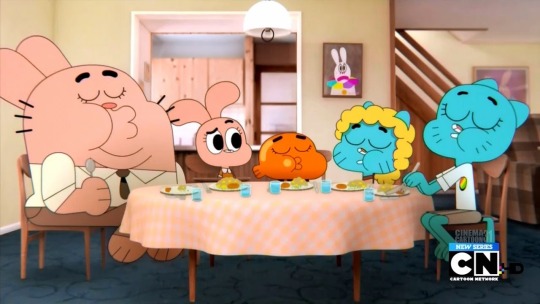
Many moments in these 10 hourlong episodes go beyond just your average cringey attempt at recapturing the magic of the source material it’s based on-it’s actively grotesque in its bastardization of the original show, which has been contorted into a full-blown black comedy by writer Christopher Yost, known for his work on Thor: Ragnarok and The Mandalorian. Netflix’s Cowboy Bebop often feels like a slap in the face. Seeing the show now, I can’t believe just how wrong I was. Its diverse, eclectic blend of musical styles, genre conventions, and multicultural imagery is a huge part of its success outside of Japan, and is something that (or so I believed) could be caught on camera well enough. Bebop is a show heavily inspired by Western culture. I’m not a person who feels particularly precious about Cowboy Bebop-it’s a wonderful show and one I’ve watched several times, but I wasn’t groaning with dismay like many when the live-action adaptation was announced back in late 2018. The show is, understandably, considered a sacred bastion by many fans it was a gateway into anime for many Millennials who stayed up late enough to catch its maiden voyage on Adult Swim as one of its very first programs. It’s since become ubiquitous-Spike Spiegel tees can be found at any local Urban Outfitters, parodies of the opening sequence featuring the Simpsons or the cast of Star Wars practically litter YouTube (including one featured in an official episode of The Amazing World of Gumball), and the anime consistently tops any list of the “best anime of all time,” including our own here at Paste. Robinson's life.Back in the day, Shinichiro Watanabe’s Cowboy Bebop was an ironclad argument in favor of anime’s coolness, a testament to the power of animation and its ability to tell unique stories other mediums struggled with. Robinson, Gumball vows to repay his debt by saving Mr. Gumball believes that he his life has been saved by Mr. George Gendi, Dave Smith, Phillip Warner, & Chuck Klein Gumball and Darwin are bored of one another and look for someone to be their third friend to make their lives more exciting. Gumball and Darwin try to show that they are responsible by babysitting Anais while Nicole and Richard are at a school meeting.īen Bocquelet, Jon Foster, James Lamont, & Sam Ward They try to avoid the result, but fail when Nicole finds out.īen Bocquelet, Andrew Brenner, Jon Foster, Mic Graves, & James Lamont
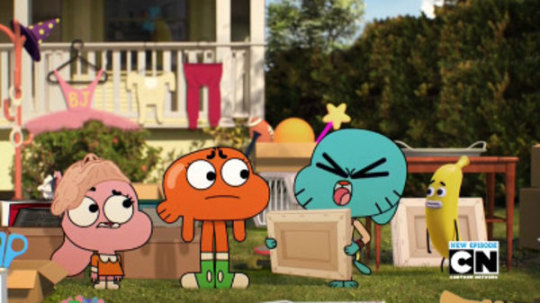
Gumball accidentally destroy a late rental DVD of Alligators on a Train. Series overview The Amazing World of Gumball series overviewĮpisodes Season 1 (2011-12) The Amazing World of Gumball season 1 episodesīen Bocquelet, Jon Foster, & James Lamont Later in November 2019, a six-episode miniseries titled “Darwin's Yearbook” was announced. Returning to November 2018, it was revealed that Ben Bocquelet has finished the show and that the production of the series was completed. Though the author of that article made a follow up article clarifying that there could still be more seasons. However, on October 7, 2018, he retweeted a tweet with an article saying that the sixth season is the final season. On September 6, 2016, series creator Ben Bocquelet announced that he would be departing production of Gumball upon completing the sixth season, but production will continue without him. The series ended on June 24, 2019.Ĭartoon Network has renewed the series for a sixth season. Since its debut on May 3, 2011, more than all 240 episodes (in total) of the series have been broadcast. It was created by Ben Bocquelet for the Cartoon Network. The Amazing World of Gumball is a cartoon comedy series. The specific problem is: Possibly take the huge notes section and work them into the tables that will eliminate a huge unneeded section by integrating them into the table.

This page or section needs to be cleaned up.

0 notes
Text
he is sooooooooooo spike spiegel ending sequence frm the real folk blues part 2 vibes.
#i love when a man sees their entire purpose for living die in front of them and dons a beige trench coat with grenades in the pocket and#has an extended hypercompetent murder break in sequence before dying violently and tragically. <333#lb
0 notes
Text
Cowboy Bebop Retrospective: Asteroid Blues

WARNING! SPOILERS AHEAD!
Hello, everybody! Welcome to the first post of the Cowboy Bebop retrospective! And since I am doing this in chronological order, let’s start with the very first episode: Asteroid Blues.
Synopsis:
The episode, and thus the entire show, opens with a black-and-white flashback sequence. Aside from the distant ringing of bells and the minimalistic tune of a music box, it is silent.

During a cold open (the only one in the series, if memory serves, and if it’s not, it certainly is a rarity), we see the main character walk solemnly in a surprisingly old-looking district considering the show is set in future space colonies, followed by footage of him involved in a massive firefight, during which he is apparently injured as blood can been flowing on his face, the scene being intercut with footage of a rose in a rain puddle, the very same one that can be seen in the header, said image slowly gaining colours. Once the scene ends, we suddenly cut to this:
youtube
With the intro over and done with, we then turn to the Bebop itself and are properly introduced to the first two of our main characters: Spike Spiegel and Jet Black, the man with the most on-the-nose name in the universe. Spike is training his sweet martial arts moves, and stops when Jet calls him for either lunch or dinner (it’s hard to tell when they’re in space).
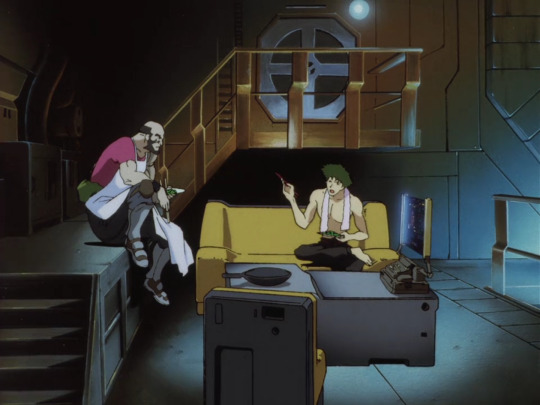
Jet briefs Spike on an interesting bounty , El Mariachi from Despera- I mean Asimov Solensan, a drug pusher, bank robber, murderer and all-around stand-up citizen hiding out in Tijuana, on the run from both the police and the mob. Which is the name of an asteroid, not the Mexican city. Get it, though? Asimov? Because this is a sci-fi show?
Meanwhile, Spike complains that his chinjao rosu has no meat in it. He starts listening again after Jet reminds him that the impressive list of bills they have as a result of Spike’s impulsiveness is the very reason they can’t afford meat in the first place.
However, even after that, Spike isn’t interested in going after Solensan, arguing that TIjuana sucks. But once Jet brings up that you can find some of the best meat around, Spike is suddenly down with his plan.
And so they’re off to Tijuana, where we are introduced to another vital staple of the show:

Yay, it’s the three old men! The guys who always seem to cross the Bebop crew somehow yet never actually have anything to do with the plot! Also, to this day, I still have it in my headcanon that the one in the baseball cap is an elderly Ash Ketchum, and nobody can convince me otherwise.
They do what they do best, which is argue, until Asimov walks in, accompanied by his lovely and pregnant wife, Katerina.

They order drinks, but it quickly becomes obvious that it’s not what they’re actually there for and before long, Asimov discreetly draws a vial of some strange purple liquid with a thin red strip inside it from under his coat and shows it to the bartender. By the way, I love how it shines despite the fact that it makes no sense considering the way the scene is lit. Let’s not forget, this may be one of the more realistic examples of the medium, but Cowboy Bebop very much still is an anime.

The two of them go to the back, where it is revealed that the drug is called Bloody Eye and is apparently very sought after and very expensive (at least “real” Bloody Eye, implying that there are cheaper fake alternatives). Meanwhile, gangsters pull over and get ready to attack. Meanwhile, the bartender insists that Asimov demonstrate use the Bloody Eye on himself to prove it’s the real deal. Through a POV shot, we are shown that the drug heightens reflexes while making it feel like time is slowing down and also giving your sight a dramatic red tint.
The gangsters attack, shooting the place up and murdering an innocent pinball machine (RIP). Asimov and Katerina, however, easily manage to fight them off, the Bloody Eye even allowing Asimov to literally dodge bullets.

And providing us with beautiful visuals.
While this is going on, Spike is consulting an old Native American shaman sitting by a bunch of discarded electronics, as you do, who tells him where to find “the red-eyed coyote” and tells Spike that he will meet a woman who will try to kill him. He also sees death after that, with Spike dropping hints about his own backstory when he says he already died once, and it already was because of a woman.

This guy is called Laughing Bull, by the way. Evidently because of his jovial disposition.
Jet finds the bar, or rather what’s left it after the shoot-out. Two more gangsters arrive, giving him the opportunity to knock one out and get the other to tell him what he knows about Asimov.
While stopping to refuel his fish, the Swordfish, Spike unknowingly meets Asimov in a dingy bathroom, then Katerina outside. She’s carrying a big bag of groceries and Spike pulls the old “bump into them to steal their shit” trick, grabbing some of her food while pretending to help her pick it up, establishing that Spike has pickpocketing skills.
When she figures it out, Katerina isn’t amused at first but actually ends up being a bit impressed once he reveals just how much stuff he managed to steal without her noticing.

You know it’s a well written show when it can honestly make stealing food from a pregnant woman look whimsical.
He gives it back and apologizes, explaining he was starving. They start having a nice chat, where we get more character development. Spike explains he’s been flying the Swordfish around for 10 years and hails from Mars. Katerina seems to have a very idealized of that planet. She dreams of leaving Tijuana to move there, as she believes that living there is a guarantee for an idyllic life. Spike replies that it’s true... if you’ve got money.
Katerina says she and her husband should be able to live there happily, then. One of those silences that speaks louder than words settles, as Spike figures it out (assuming he wasn’t just putting on a show up until now) and asks her if she and Asimov truly intend to move there and spend their life on the run.

Asimov catches him off-guard and starts choking him. He probably would have killed Spike too if it weren’t for Katerina telling him to stop.
Jet finds Spike and tells him he’s giving up. It’s too hot, everyone who goes after Asimov ends up dead. Spike, however, shows that he managed to snatch one of their Bloody Eye vials and fully intends to keep going after them.
And he does! Finding them in a restaurant, he confronts Asimov. An amazingly directed and animated fight scene ensues.
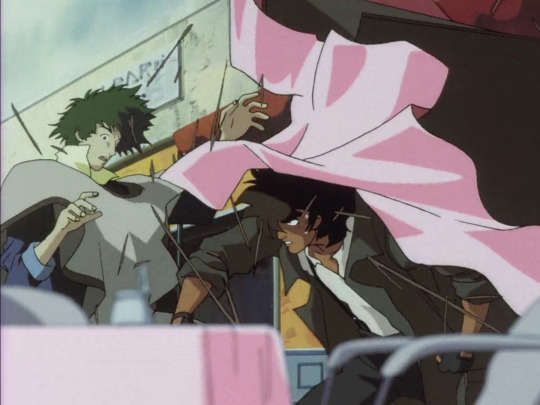
It is broken up when more mobsters show up, both in the air with aircrafts and on the ground with cars. Katerina and Asimov make their escape, but in the middle of all the excitement, a stray bullet grazes Katerina’s belly, which doubtless sends the audience in a cold sweat... until Bloody Eye starts spilling out, revealing she wasn’t pregnant at all and her fake stomach was actually a cache (points for cleverness, wonder if any drug pusher tried that in real life).
Asimov yells at her, screaming that they’re done for if they lose the drugs. At that moment, Katerina seems to come to a horrific realization.
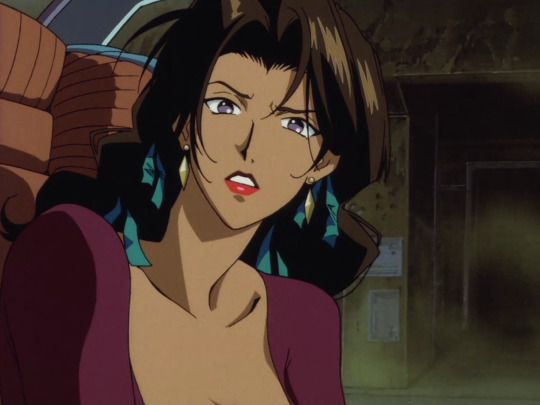
The mobsters don’t stop coming, but Jet saves the day, ramming their cars with his craft, the Hammerhead, whose tip looks like it belongs more on an excavator than on a spacecraft.
Asimov and Katerina escape and Spike is hot on their tail, taking out several mob ships in the process. Spike is getting ever closer to them as they desperately try to run away. They all escape the city and reach space, only for them to be face by a police barrage, literally hundreds of ship ready for them. Stuck between the cops, bounty hunters and the mob and with her husband’ mind and body being swallowed up by dope, Katerina no longer has it in her to keep fighting.
“There will be no honeymoon on Mars. This is the end of the road” she says. Giving her man the mercy of a quick death, she looks a shocked Spike straight in the eyes as she awaits the hail of bullets from the cops.

We cut back to the Bebop. Bookending the episode is Jet cooking. He can’t find Spike in his usual spot though. He finds him in a windowed room, staring longingly into the eternity of space after he finishes training. Spike asks what’s for dinner, and Jet replies “a special chinjao rosu”.
Thoughts:
Ho boy, what a way to start the show. Now, if I’m being honest, this is a fairly run-of-the-mill episode for Cowboy Bebop, but that says more about the quality of the show than it does about that of the episode, because it was great. And while it’s in my opinion not among the best the show has given us, I think it was an excellent first episode.
It represents the show perfectly, everything you need to know about it in terms of tone, style, aesthetics, characters and storytelling is here, which is no doubt why it did such a great job of capturing people’s attention. After you’re done seeing the episode, you know this isn’t your average anime. And indeed, I heard the message loud and clear, especially since my idea of anime at the time, and really TV in general, was stuff like Pokémon and Card Captor Sakura, so needless to say, this blew my mind, especially considering I only check it out to see what this show that took The Simpsons’ slot on the channel was. My 11-year-self* was like “are you even allowed to make stuff this good on TV? Let alone in cartoons?”.
And yeah, I think this is the show that really made me realize that cartoons could be made for an adult audience (as well as 11-year-olds with a taste for things not for his age) and be mature, thought-provoking and immensely emotional. I’m really not sure the show would have been so successful if it didn’t make this good of a first impression.
And make no mistake, it being an “average” episode by Cowboy Bebop’s standards doesn’t mean it doesn’t have its memorable moments, as the image of Katerina floating into space while drugs spill out of her has been stuck in my mind from the very first time I saw it, and it’s still one of the things my mind goes straight to whenever I think of the show.
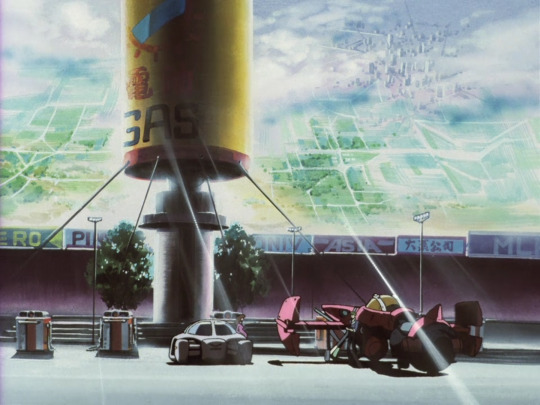
So yeah, it establishes the first two of the main characters, and while this is by now means the only, let alone the first show to gather its cast over time, I think this is especially nicely done here as the fact that there’s only two of them so far really gives time to develop them well in spite of the episode only lasting about 20 minutes (not counting the ending credit and teaser for the next episode).
Jet being introduced by cooking immediately speaks volume about him, showing that in spite of his massive size and fairly scary appearance, he’s by far the nicest and most restrained one of the group, preferring to stay behind and supervise everything, and enjoying quiet activities, but it also shows he can occasionally be the muscle of the group as well in the couple action scenes he gets.
I’ve seen him described as “fatherly”, and I think that fits him well. An older, stern, physically imposing yet disciplined and calm man, who takes care of the home life and is generally the voice of reason, but does have a sense of humour and can get tough when necessary, mostly to protect the people he cares about.
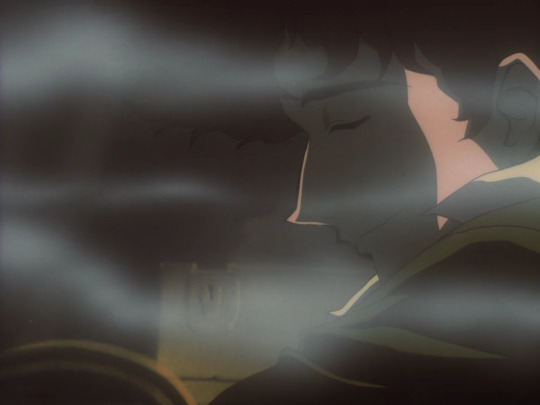
Spike’s major characteristics are laid out as well. From his physical prowess to his generally laid-back attitude, his sarcastic sense of humour and his nihilism (in a good way, as in he doesn’t think life has any inherent meaning or purpose, but that only means you’re free to give it whatever meaning and purpose you value).
As I alluded to earlier, this first episode also does a great job of giving people a good idea of what to expect in terms of visuals. Thinking about it, this is definitely one of the episodes that falls the furthest on the “western” side of the show (I mean, it’s set in a place called Tijuana, for crying out loud!), but sci-fi elements still pop-up, such as the gates, and I think it was a good idea to introduce them in the first episode in order to make people comfortable with it, as these are definitely one of the harder sci-fi elements in the show, and I’m not sure people would have just gone with it so easily if they’d gotten used to the more realistic aspects of it first.
There’s an especially great moment near the end of the episode that I think illustrates the show’s mixture of western and sci-fi perfectly, as the characters are flying off into space, we see the background quickly shift from the old-fashioned run down city to the vast emptiness of space, with the gates and spacecrafts, in like a second, it really goes to show how these two styles clash yet also merge.
We also get small touches you may not have noticed at first (but your brain did), like having parts of the city being visible almost at an 90 degree angle in the background, the unnatural visual reminding you that in spite of the realism, this IS a sci-fi show.
Another aspect of the show this episode establishes right away is the cultural diversity.
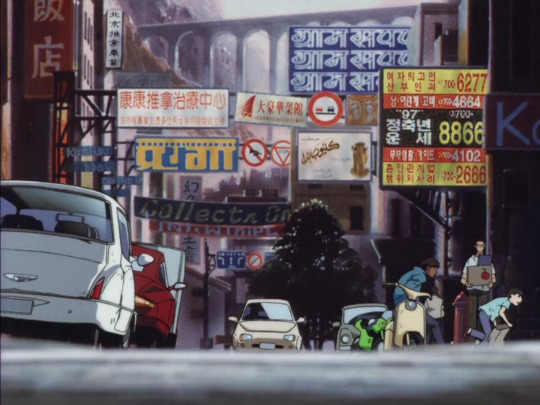
Yes, Cowboy Bebop is very famous for portraying a multitude of cultures and ethnicities, something you didn’t see much in Japanese works of the time (and you still really don’t). The world of Cowboy Bebop frequently features Black people, Middle-Eastern people, Asian people, Native American people (as seen in this very episode), etc... and various people of mixed ancestry. And just look at the above screenshot, where you can see Japanese, Chinese, Arabic, English, Korean and I think I see some Russian and perhaps Thai.
This is something that carries on throughout the show as signs are often translated in many languages, and the announcements at the gates can also be heard in multiple languages. It makes sense when you think about it. People left the Earth to colonise the Solar System, and the earliest settlers would probably be people from all over the world being mixed together. They probably wouldn’t just give up on their cultures, but they’d end up being far closer together than they used to.
By the way, that diversity isn’t just for show and the writers have clearly done their homework as Laughing Bull can be heard calling Wakan Tanka to protect Spike, Wakan Tanka apparently being a spirit (and not just any but “the great spirit”) according to Lakota Sioux beliefs.

Another aspect it shows very well is the atmosphere and tone. It is very dark and heavy in places, but it’s also got some lighter moments. It also displays the show’s affection for tarantinoing. You know, when characters are having dialogue that has nothing to do with the plot and they’re just bullshitting around to add to the general feeling of a scene and the work as a whole?
Now of course, it doesn’t take it to Tarantino’s extremes, and it’s usually in the middle of a scene that is related to the plot, like with Spike complaining that he finds Jet’s lack of beef disturbing while Jet himself is trying to talk business, but it’s nice that it’s there. It’s something love (probably a big part of the reason why I like Tarantino movies so much). I think it adds a lot of character to a work. It makes the world feel much more alive as it shows that the people inhabiting it do have lives outside of the story we’re following.
I’ll take an average story in a world I feel attached to over a carefully crafted one that doesn’t make me care about the world it’s set in. And here, we have a great story set in a world I love, it’s the total package!
Oh yeah, and this is also the first appearance of the Bloody Eye, a very interesting bit of lore, as the drug ends up showing up again and becoming a major plot point later on. I also like the implication that there’s fake Bloody Eye, which is a surprisingly realistic detail for a fantasy drug, as in real life, cheap alternatives to expensive drugs are a thing, and they usually are cut down with all sorts of shit that makes it even worse for your health than the real stuff. Again, there’s a contrast between the very fantastical look of the drug versus the realistic implications of its existence.

Next, I have to mention the visuals because man! I remembered the animation being good, but I never realized it was THIS good. I guess maybe becoming an artist myself has made me gain even more respect and appreciation for this sort of work, but the animation on Cowboy Bebop is still impressive to this day.
The characters and vehicles are pretty much always on model (and indeed, I don’t remember ever seeing a scene that looked off in this show) in spite of being very detailed.
In that regard, some of the shots that I found the most impressive are actually ones of very little importance, like Jet tossing his bell pepper in the pan. Just think for a second of how much of a pain in the ass it must have been to draw several frames of these goddamn peppers, keeping track of which one goes where and making sure their shape and size stays consistent.
Another very impressive one is one Jet arrives to save the day, and we are then treated to a shot of the Hammerhead with Jet inside it slowly tilting downwards. Again, being able to keep all these details consistent, and drawing all these frames at a slightly different angle each time to give the impression of the camera panning, is nothing short of stunning if you have any idea how difficult and time-consuming animation can be.
I heard a big part of the motivation behind Cowboy Bebop was to showcase the studio’s animation abilities, which is why it often has weird trippy scenes and bizarre characters and locations, well mission fucking accomplished, guys!
I also want you to look at the screenshot above because another aspect of this show’s look I always loved is the expressions and body language, being, again, very realistic, but still ever so slightly exaggerated to give it more life. I especially remember this being one of the few shows that often had the characters’ entire jaw move when they talk, not just their mouth. This ended up being a big influence on me as this is how I strive to draw my characters myself. Animated enough to feel intense, but still realistic enough to be relatable.
And as much as I liked anime at the time, I always got annoyed whenever it went super deformed, and I still do, as I usually felt it was trying way too hard to be wacky and ended up ruining its own attempted effect, so it was very refreshing to me to see an anime that kept it believable, but still remembered it was a cartoon, and to take advantage of that fact when they do need to show more dramatic expressions like Asimov’s psycho grin up there.
It’s not just characters either, as we often see parts of the vehicles shake and rattle, and even some details I wouldn’t have thought of but which add a lot, such as a car springing up and down slightly as characters sit in it or exit it. Very very nice attention to detail.

And last but not least, concerning the visuals, yet another thing I love about the show’s aesthetics, and something that helps it feel very grounded, is how almost everything is a bit used up. You have all sorts of little details like scratches on mechanics, cracks on walls, graffiti, posters, dirt, etc... all things that further help make the world feel lived-in, rather than just decoration for a story. They’re like so many scars letting you know that a lot happened there and those who lived to tell the tale have seen some shit.
Now, I also have to bring up the writing. I actually don’t have much to say in the regard. It’s just plain good, and pretty much everything I’ve talked about so far is kind of part of the writing process already, and once again, this first episode does a very good job of letting us know what to expect. Sad moments, happy ones and everything in between.
One thing I will say that never really registered in my mind but that I noticed when re-watching this is that sometimes, we don’t quite know how the characters got where they did and knew where to go, they just kind of show up where they need to be.
But that’s not a bad thing! Because we really don’t need to see how they knew where to go. We can surmise they found some info, followed some trail, or even just made an educated guess on their target’s most likely destination, but to see scene after scene of them tracking their bounty would be pointless, so just having them be there makes the most sense and keep the story flowing (again, keep in mind they only have 20 to 25 minutes per episode).
That’s another thing to keep in mind for any writers out there (including myself): we don’t need to know the exact details of how or why something happened. As long as it doesn’t create plot holes, if we can have a good idea of how they did it, if it makes sense for them to be able to do it, if it doesn’t add anything to either the story, the characters, the lore or the atmosphere, you can skip to what’s important.
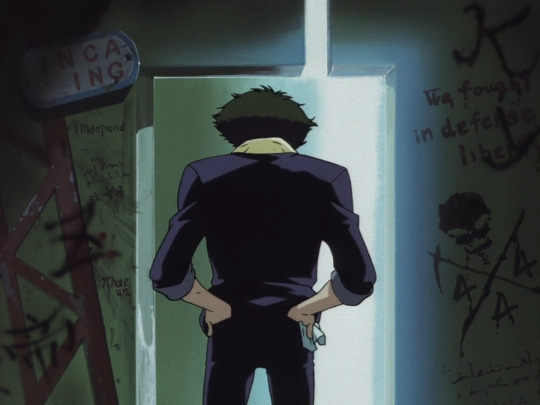
And last but certainly not least, there’s the music. I mean... how can you talk about Cowboy Bebop and not talk about the sublime soundtrack by Yoko Kanno and the Seatbelts?
Yet again, this episode sets the mood by showcasing some of the common theme tunes of the show and letting you know that you’re own for lots of western-inspired music and lots of blues, jazz and bebop (who would have thought?).
It all complements the visuals perfectly, and it’s probably not an accident that the show opens with no dialogue or sound effect, but with music, going from the melancholic sounds of a music box to the extremely energetic “Tank!” in the intro, yet another thing highlighting the contrasts of that show.
However, having said that, one thing I noticed through this episode is that, as deeply as it is tied to the show, it doesn’t play all the often. Most of the scenes have no background music. That’s another thing that keeps the show feeling down-to-earth and realistic, and much like with the expressions, it makes the times when it does get stronger all the more powerful.
Trivia / matters of interest:
Couple interesting things I noticed regarding the French dub (which, as I alluded to in my announcement, is excellent, it’s worth noting for anime). I remember that in the English one, Jet describes the food he’s preparing as “bell pepper and beef”, which, you know, is one way to call it, but as I mentioned, the French dub does go the whole hog and gives it its Chinese name, Chinjao rosu, which I feel fits in well with the whole “cultural mixture” thing the show’s got going. Plus, I fele like Jet explicitly mentioning beef makes it sound like he’s just being a dick to Spike.
However, while the French dub is good, it’s not perfect, so we have some weirdness, as Laughing Bull refers to Asimov as “the red-eyed coyote”, which of course alludes to his drug habit, whereas Spike later calls him “the red coyote”, omitting the eye part. Granted, I realize it’s a nitpick and you could easily explain that away as Spike not remembering fully, but I just like “red-eyed” better.
As I mentioned before, Tijuana is a real place and interestingly, this one has a place called Zona Norte, which also exists in the real Tijuana and is a red light district. Guess the settlers who founded this town must have been Tijuana natives.
And that’s it for this first episode. I hope you liked it, thank you very much if you stuck to the end. I realize this was a long read but since this is the first episode and gives me an opportunity to mention recurring elements from the show, I really wanted to cover everything. Future instalments should be shorter. I’m also hard at work on the next part of the FF8 translarison. That’s gonna be a big’un too, so I’m not sure when it’ll be posted, but the screenshots are all done, promise.
You know, this episode was pretty much the perfect average of everything Cowboy Bebop, and yet it was still one of the heavier episodes of the show. We need some levity to clear the air a bit, so thankfully, next time, it’s all about a cute puppy, in Stray Dog Strut!
* I first saw it in the summer of 2000 when it was shown on a channel called Canal +. It was not actually the first time it was aired over here but I do believe this is when it got really popular, as the channel that first broadcast it was a smaller satellite channel, with satellite television not being very big yet at the time.
#Cowboy Bebop#cowboy#Bebop#retrospective#anime#bloody eye#drugs#analysis#review#Asimov#Katerina#Solensan#bounty hunter#bounty hunting#first#episode#pilot#recurring#themes
15 notes
·
View notes